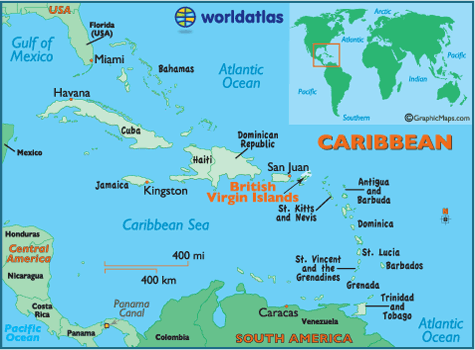Virgin Islands (British)
AN OVERSEAS TERRITORY of the UNITED KINGDOM, and poorer cousins to the U.S. VIRGIN ISLANDS, the British Virgin Islands have looked to their larger and more populous neighbors to the west for much of their economic and cultural influences: most tourists to the islands are from the mainland UNITED STATES, and the islands have used U.S. currency since 1959. But recent British regulation of offshore financial activity and criminal activity in the islands, along with a reputation for stable government, has given the British Virgins a new identity as one of the most attractive places for international investment in the Caribbean.
The British Virgin Islands are grouped around Sir Francis Drake Channel, just to the west of the Anegada Passage, a key deepwater route from the ATLANTIC OCEAN to the CARIBBEAN SEA. The group contains about 36 islands altogether, but only 16 are inhabited. The largest of these are Tortola, Virgin Gorda, Anegada, and Jost van Dyke. All of the larger islands are volcanic in origin (though long extinct), except Anegada which is a coral and limestone formation. These differences in origin are evident in the topography: the volcanic islands have steep hills and rocky cliffs, while the coralline islands are mostly flat. All of the islands were deforested long ago, though some areas have been replanted with mangoes and palm trees, as well as mangroves. Other places remain dry and desolate.

The hillsides contain water catchment areas to provide fresh water, along with desalinization plants. There is not much agriculture; what is produced is strictly for domestic consumption, not export. But the area's lack of rain is a blessing for tourism. The British Virgins are not developed for large-scale tourism, but prefer to retain an industry based more on up-market tourists—more than half of the visitors to the Virgin Islands charter yachts during their stay. Other visitors are attracted to watersports, sailing, and quietness, especially on the string of smaller islands facing the south coast of Tortola: Norman, Peter, Dead Chest, Salt, Cooper and Ginger. A new cruise ship pier was built in the 1990s in Road Town, Tortola, but was purposefully limited to keep out the largest ships.
The eastern Virgin Islands were first settled by Dutch traders in 1648, but the islands were soon annexed by the British. Most of the population are descended from African slaves brought to work sugar plantations in the 19th century, either here or on other islands of the West Indies. About half of today's population are immigrants from other islands who have come here to find work in the growing tourism industry. A century ago most of the population lived on Virgin Gorda, but the majority has since moved to Tortola, where 80 percent of the population currently lives. Virgin Gorda has the islands' most popular natural attraction: the Baths, where giant boulders form a series of grottoes and pools. Jost van Dyke was a pirate haven for many years and is still fairly isolated, with only about 300 residents. Anegada has even fewer people but is instead the home to large iguanas, green turtles, and flamingos, whose numbers are now protected in a wildlife sanctuary. Anegada is also popular among divers for its numerous (over 300) shipwrecks and pristine coral reefs.